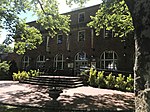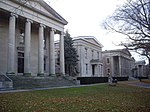New York Chinese Scholar's Garden

The New York Chinese Scholar's Garden (simplified Chinese: 寄兴园; traditional Chinese: 寄興園; pinyin: Jìxīng Yuán; Jyutping: Gei3hing1 Jyun4) is part of the Staten Island Botanical Garden, located in the Snug Harbor Cultural Center. Materials were shipped to Staten Island in the spring of 1998, when a team of 40 Chinese artists and artisans from Suzhou constructed the garden. It opened in June of 1999. President of the Botanical Garden Frances Paulo Huber recognized the need for an authentic Chinese garden in 1984. The garden was finally constructed with the support of many partners, including the Staten Island Botanical Garden, the City of New York, the Landscape Architecture Company of China, the Metropolitan Chinese American Community, various private foundations, and hundreds of individuals and corporate donors. After a long series of collaborations a contract was signed with the Landscape Architecture Corporation of China. Mr. Zou Gongwu was appointed as chief project designer.
Excerpt from the Wikipedia article New York Chinese Scholar's Garden (License: CC BY-SA 3.0, Authors, Images).New York Chinese Scholar's Garden
Cottage Road, New York Staten Island
Geographical coordinates (GPS) Address Website External links Nearby Places Show on map
Geographical coordinates (GPS)
| Latitude | Longitude |
|---|---|
| N 40.641944444444 ° | E -74.104444444444 ° |
Address
Chinese Scholar's Garden
Cottage Road
10301 New York, Staten Island
New York, United States
Open on Google Maps








